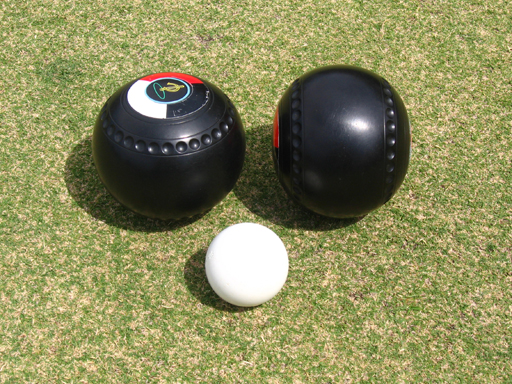Use 'Print preview' to check the number of pages and printer settings.
Print functionality varies between browsers.
Printable page generated Thursday, 25 April 2024, 5:42 AM
Unit 8: Sport
Introduction
In this unit you will learn about Scots language and Sport, introducing you to words which have been used to describe objects which are particularly relevant to Scottish sporting culture. Many of these sports were invented or codified in Scotland. Many have gone around the world to become international sports.
Some of the words we use in Scots have therefore become common around the globe, thanks to the importance of Scotland in the development of world sport.Those which have carried Scots culture around the world are: Bowls, Curling, Golf and Football. We will look at these games and study the many terms which are associated with objects from the sport or which describe the players or aspects of the game.
Important details to take notes on, throughout this unit:
A comparison of the games of Curling and Bowls, and Scots words related to these games
The history of men’s and women’s Football in Scotland
The influence of Scottish culture on important world sports as seen in Scots sports vocabulary language links
The history of the ‘tools’ used for playing Golf
Activity 1 
Before commencing your study of this unit, you may wish to jot down some thoughts on the four important details we suggest you take notes on throughout this unit. You could write down what you already know about each of these four points, as well as any assumption or question you might have.
8. Introductory handsel
A Scots word and example sentence to learn:
Definition: A sweeping implement.
The spelling besom in Sc. is often deceptive, as the pronunciation in many cases is better represented by bissom or bizom.
Example sentence: “…at the call of the skip, ‘Soop her up’, down came the besoms like lightning…”
English translation: “When the captain of the curling team shouted his instruction to start brushing, the brooms were immediately placed on the ice.”
Activity 2
Click to hear the sentence above read by a Scots speaker.
You can then make your own recording and play it back to check your pronunciation.
Transcript
Listen
…at the call of the skip, ‘Soop her up’, down came the besoms like lightning…
Model
…at the call of the skip, ‘Soop her up’, down came the besoms like lightning…
Go to the Dictionary of the Scots Language for a full definition of the word
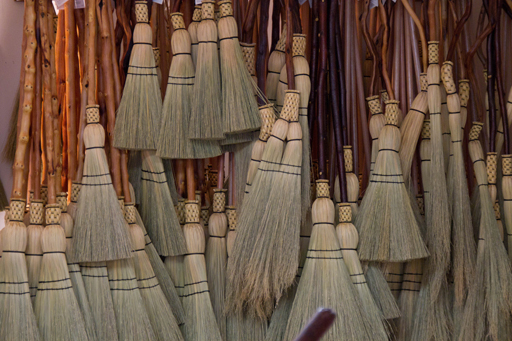
Language links
In the context of the sport of curling, a besom is the long handled broom which Curlers use to brush the ice in front of a curling stone. The stone will have been propelled towards the target, known as the ‘house’. In doing so, the friction of brushing makes the ice melt and allows the stone to keep 'roaring' on. The sound of the stone sliding across the ice gives Curling its nickname of the “Roaring Game”.
Skilled brushing can change the direction of a stone. The word once literally meant the plant from which the besom was made: the broom plant. The branches of the broom plant were tied together to make a broom for sweeping. The word comes from the Old High German brâmo, meaning bramble.
The word is also a popular Scots noun that is used to describe a young woman or girl who is badly behaved or cheeky:
Example sentence: Haud your wheesht, ya wee besom!
English translation: Please stop talking, you cheeky young woman!
[Literally: ‘hold your silence..’]
The Oxford English Dictionary suggests that the two words are entirely unconnected. It is a coincidence that they sound the same. However, in German, the word besen is used as a name for a maid servant or young girl.
Related word:
Definition: In curling, to sweep (the ice) in the path of a curling-stone in order to assist its progress; to speed up (a curling-stone) onwards by so doing.
Example sentence: …at the call of the skip, ‘Soop her up’, down came the besoms like lightning…
Activity 3
Click to hear the sentence above read by a Scots speaker.
You can then make your own recording and play it back to check your pronunciation.
Transcript
Listen
…at the call of the skip, ‘Soop her up’, down came the besoms like lightning…
Model
…at the call of the skip, ‘Soop her up’, down came the besoms like lightning…
Go to the Dictionary of the Scots Language for a full definition of the word

Language links
In curling, the stone is thrown towards the ‘house’ or target of concentric circles. Unless the curler is exceptionally gifted and the ice is perfect, a pair of players will have to brush the ice to make it melt. This reduces friction and allows the stone to continue on a straighter path. As it slows, it starts to curve in its trajectory, which may or may not be a good thing. The skip will observe the path of the stone.
Please note that the word soop has no connection to the English noun ‘soup’, even though the latter spelling has been used to describe the act of sweeping. Remember that the spelling of words was less important than the sound, for centuries. It was not until the printed word became so common, that single spellings of words had to be agreed, so that there was consistency across publications.
If you want to learn more about sooping in curling, watch this video published by World Curling TV.
Another related word:
Definition: In curling or bowls: the captain and director of play of a rink or side of players
Go to the Dictionary of the Scots Language for a full definition of the word
The word skip is the shortened form of skipper or captain. This person is normally the best and most experienced curler, who directs the play and is ready with the directions for sooping up the stane or curling stone. Like many other Scots words, skip shares a heritage with the Middle Dutch word schipper, coming from schip: a ship. Therefore, the skip is metaphorically the captain of the ship i.e. they have total control of the members of their curling team.
8.1 The Sport of Curling
Curling is an outdoor sport played on ice. It was invented in medieval Scotland with a first written reference from Paisley Abbey just to the west of Glasgow, in 1541. Most games are now played indoors, due to the warming of Scottish winters since the ending of the ‘Little Ice Age’ in the 1800s.
This is a slightly humorous drawing of curlers waiting for a stone to be delivered down the ice. Their besoms are very much like the plant in Kohler’s Medicinal Plants published 1887 and the ones shown in the image that comes with the introductory handsel of this unit. They are basically a bundle of sticks tied together.
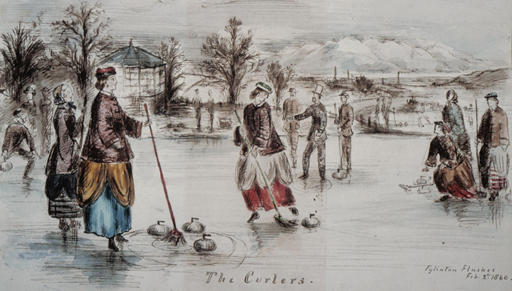
Originally, the stones which were used to throw on the ice, came from the beds of rivers and were known as channel stanes in Scots. They were stones from the course or ‘channel’ of running water and smoothed by that running water. In the 19th century, the stones were taken from an area of hard granite from the island of Ailsa Craig (Aillse Craig or in Scots Gaelic fairy rock) in the Firth of the river Clyde. The stones were given handles and were worked into a circular shape. The curling stones drawn by John Kerr in his History of Curling (1890) looked very similar to this modern curling stone in the photograph.
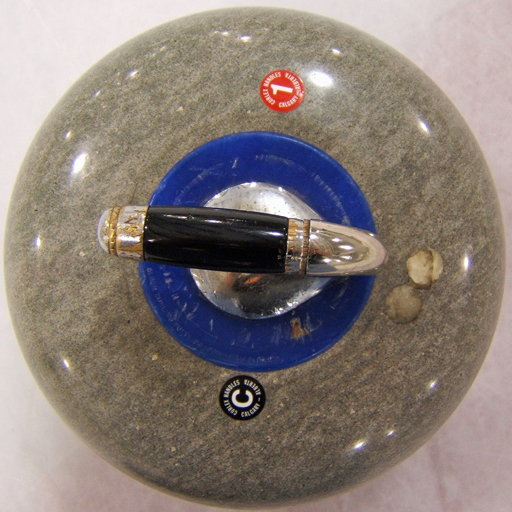

In this image from Canada, a player with his besom is sooping up, as the stone is about to strike another. Changing the direction or speed of the stone by even a few centimetres or metres per second can be the difference between defeat and victory and is a skilled task.
Curling is a game played internationally. It was codified in Scotland. The world's oldest national association is the Royal Caledonian Curling Club (RCCC), founded in 1838. The World Curling Federation (WCF) was founded by the RCCC and is based in Perth, Scotland.
Activity 4
In this activity you will work with two Scots words closely related to Curling.
Search the online Dictionary of the Scots Language for the two words: crampit and loch.
Take a note of the definitions for these two words and find a reference for each word, which relates to the sport of Curling. One is a piece of equipment and one describes a place which is extremely important in Scottish culture.
Answer
Word 1:
Crampet, crampit, cramp-bit, n. Cf. Cramp, n.2 [′krɑmpɪt]
5. A flat piece of iron with 4 spikes, bound to the sole of the shoe to keep a curler from slipping.
6. The iron sheet on the ice on which curlers stand when delivering their stones (Abd.9, Fif.10, Kcb.10 1940). Cf. Cramp, n.2, 3.
Word 2:
Loch, n., v. Also lauch; ‡louch (s.Sc. 1873 D.S.C.S. 119), †lough. [lɔx, s.Sc. + lʌuxʍ]
I. n. 1. A lake, a sheet of natural water, an arm of the sea, esp. of the fiord shape (Sc. 1755 Johnson Dict., 1808 Jam.). Gen.Sc., universally applied to natural lakes, except the Lake of Menteith in Perthshire. Lake is used only of artificial formations (except as under Lake).
8.2 The Sport of Gowf
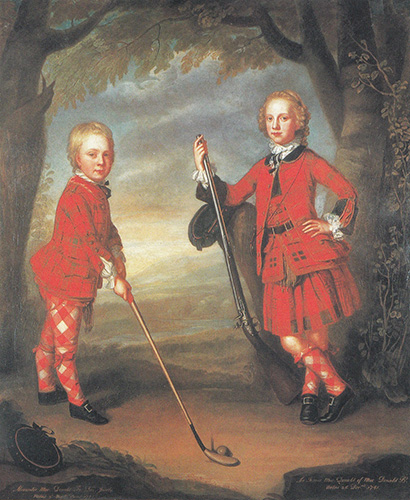
Golf is a stick and ball game played outdoors. The object of the game is to drive a ball, in as few strokes as possible, into a small hole. A variety of clubs of differing types can be used in this endeavour. The modern game is seen as a Scottish invention, although what is now played in the Netherlands has linguistic evidence that people there played a similar sport to modern golf.
Activity 5
In this activity you will engage with some key Scots words related to the game of gowf. The first Scots word and example sentence for you to learn are:
(another spelling as seen in the example sentence is gouf)
Definition: The game of golf, played first in Scot. in the 15th c. and popularised in Eng. about 150 years later. n. A dull blow, a hit, slap, buffet
Example sentence: “When the expresse came to him [King Charles I] with letters giving accompt of the Irish Massacre, he was playing at the gouf in the Links of Leith.”
(Wodrow, Analecta, 1842)
Part 2
Click to hear the sentence above read by a Scots speaker.
You can then make your own recording and play it back to check your pronunciation.
Transcript
Listen
When the expresse came to him [King Charles I] with letters giving accompt of the Irish Massacre, he was playing at the gouf in the Links of Leith.
Model
When the expresse came to him [King Charles I] with letters giving accompt of the Irish Massacre, he was playing at the gouf in the Links of Leith.
Language links
There are interesting language links with the Scots word gouf or gowf, which relate to the two definitions of the word. You can see that whilst one is applied to the game itself, the other is a noun meaning a blow or a slap. It is possible to see how this word was used in other sports which struck a ball.
Please note that the word gowf or gouf is an example of a word that has close links to languages spoken in other countries. In the Netherlands there were two games called kolf or colf. The Dutch word colve means a stick, club or bat. The Dutch had the word kolf for a club and kolf-bal - a ball for club games. Gouf or gowf is also related to the Old Norse kolfr meaning the clapper of a bell.
The main difference in the sports is that Scots played theirs as an outdoor game on links courses and struck the ball towards a hole in the ground. In the Netherlands it seems that the ball was struck towards an above-ground target like a tree, a stake or sometimes a hole.
There is a useful and very famous related word to gouf in Scotland:
Definition: The sandy undulating ground, gen. covered with turf, bent grass, gorse, etc., which is freq. found near the sea-shore on a flat part of the coast, and is often common ground belonging to the nearest town.
Again, there are interesting Language Links here:
The word links is related to the Old English word hlinc meaning rising ground or a ridge. In the Scottish use of the term, it mostly refers to the undulating dunes seen at the seashore. It appears often in Scottish place names such as Bruntsfield Links, Dornoch Links and the Links of Montrose. The term has come to mean ‘golf course’ for many people.
The reason for the use of links for the game of gowf is entirely pragmatic. The soil of links is sandy and unsuitable for arable farming. It is likely to be on the coast, where the populations of most countries lived until the Industrial Revolution created cities near primary resources for industries such as coal and iron. Grazing animals could keep grasses cropped and rain was not a problem, as the sandy soil drained very quickly – ideal conditions for playing gowf.
Please note that the Netherlands and the east coast of Scotland have strong cultural connections through trade. It is not surprising that the two countries share a history of stick and ball games. Look at pictures of east coast towns like Culross to see a strong Dutch influence in architecture.
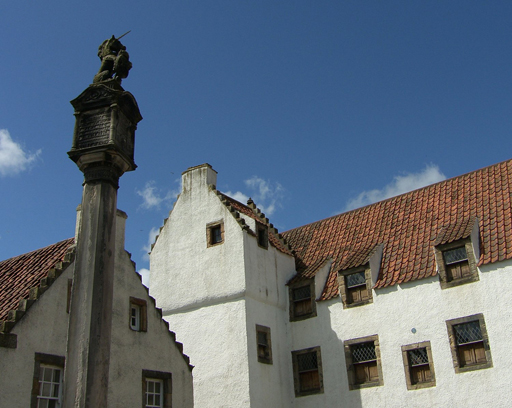
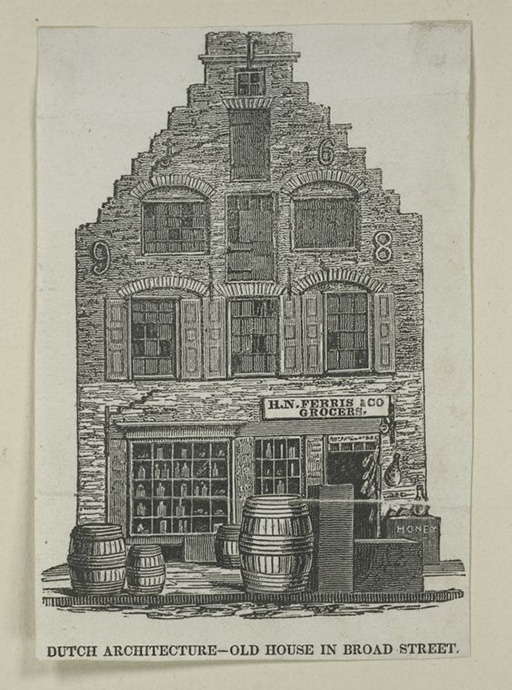
Until the 1930s, most golf clubs came from Scotland. They had predominantly hickory shafts and leather grips and there was no limit to the number of clubs a golfer could use. They were each named with a Scots word. However from 1939, the Royal and Ancient Golf Club of Saint Andrews (R&A) introduced a rule that a player was only allowed a set of 14 golf clubs. The clubs were numbered and each was of an agreed type and usage e.g. putters or drivers. As the R&A were the supreme arbiters of the rules of the Game outside of the Americas, it meant that, ironically, usage of the Scots words for clubs declined.
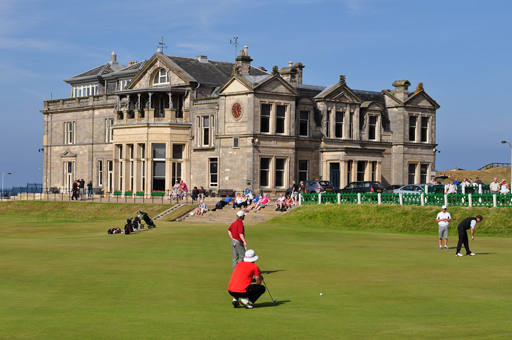
Activity 6
In this activity you will learn some Scots names for the most commonly used golf clubs.
Match the descriptions of the clubs with their names by dragging these to the correct place.
You may want to use the Dictionary of the Scots Language to help you. But maybe you have heard these words before and do not need the dictionary at all?
Using the following two lists, match each numbered item with the correct letter.
Mashie
Niblick
Jigger
a.n.[′mɑʃi] 1. An iron golf club introduced c.1880 and used for approach shots, having a straight sole and face with the face at a medium angle to the shaft.
b.A golf-club with a small, round, heavy head, and a strong shaft, designed for getting the ball out of an awkward or constricted position, corresponding to the No. 5 iron.
c.n.2 An iron golf-club, popular at the beginning of this century, corresponding to the modern no. 4 iron.
- 1 = a
- 2 = b
- 3 = c
Answer
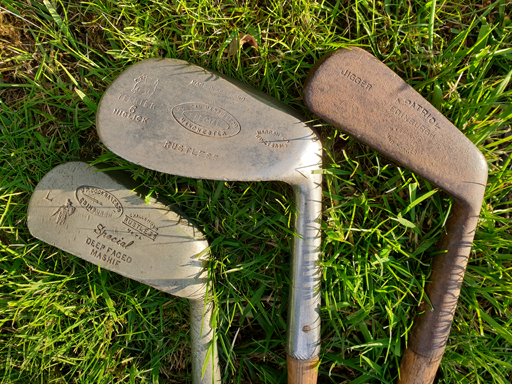
8.3 The Game of Bools
Bowls is a game codified by the Scots and exported around the world. The Wellcroft Club in Glasgow (founded 1835) have the ancestor of the world rules in their first minute book. The Scottish Bowling Association (SBA) was the world’s first national association: founded 1892. If you do extension research on sport in Scotland, you will quickly see how Bowls and Curling are very similar in their tactics and field of play. Further study will show how words such as rink can also appear in quoits and racing generally.
Activity 7
Part 1
As with the other types of sports, you will start your work in this section with some Scots words relating to bool.
Here are a Scots word and example sentence connected to the game for you to learn:
Definition 2: A bowler's bowl, a “wood.” Gen.Sc. 3. Extended to mean the game.
Example sentence: “The bool rolled across the rink and kissed the kitty.”
English translation: “The bowl rolled across the grass and just touched the jack.”
Please note: The name of the game is the same as the name of the item/tool the game is played with.
Part 2
Click to hear the sentence above read by a Scots speaker.
You can then make your own recording and play it back to check your pronunciation.
Transcript
Listen
The bool rolled across the rink and kissed the kitty.
Model
The bool rolled across the rink and kissed the kitty.
Go to the Dictionary of the Scots Language for a full definition of the word.
Language links
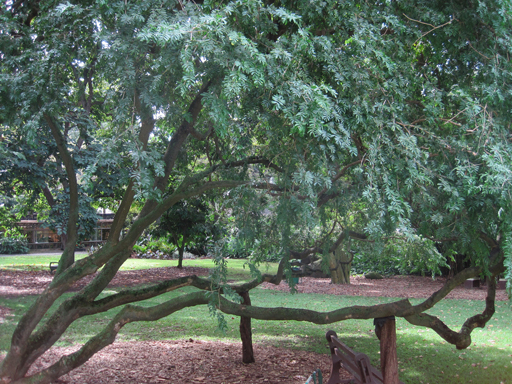
The bowl is called a ‘wood’ because it was originally that: a bowl made from lignum vitae: one of the hardest woods in the world. Until the advent of modern composite materials, the oldest bowls manufacturer in the world, Thomas Taylors of Glasgow, used lignum vitae.
“Back in the 1800's, when all bowls were shaped by hand to a template and consequently, no two bowls were exactly alike, Thomas Taylor made and patented a machine for shaping bowls accurately. In that same year the Company introduced the world's first testing table for bias of bowls.”
There are two useful related words to bool.
Related word 1:
Definition:
1. The piece of ground marked out for a contest, combat, race, etc., an arena.
2. The area of play marked out in the games of curling and quoits.
Go to the Dictionary of the Scots Language for a full definition of the word.
Language links
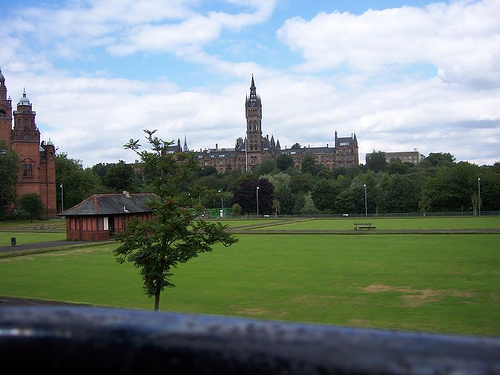
The term rink comes from the Old Scots word renk meaning an arena for combat. English words such as rank and range all come from the same origin: the Old French renc or ranc and before that the Old Teutonic cognate ring. This gives a word which suggests a boundary area. In modern bowls, the game is played on a large area of grass called a bowling green. Within the space of the green are rectangular areas of play called rinks. The bigger the area of grass, the more rinks that can be created.
Related word 2:
Definition: 3. The jack or white ball aimed at in the game of bowls. Also kit, id.
Go to the Dictionary of the Scots Language for a full definition of the word.
Language links
Like curling, the object of the game is to throw your bool down the rink and come closest to an agreed point. The bools closest to the agreed point are the bools which score the points. Where curling marks a set of concentric circuit lines on the ice and calls it a ‘house’, in bowling a white ball, called a kitty, is thrown down the rink, to act as a target. In English the word would be ‘jack’. Therefore, the phrase ‘kissing the kitty’ is a bool that is almost perfect and has come to rest, lightly touching the kitty. It is, by definition, almost impossible to get a competing bool any closer.
Note that the term kitty is also used to denote an object hit in the game of Shinty: another ancient Scottish stick and ball, field game.
When studying the two sports of Bool and Curling, you will have noticed that these two games have much in common. Here are some more aspects that apply to both games:
both were codified in the 19th century
both are team games
both have become international sports
both are tied to locality
both are played on a long, rectangular surface
they complement one another, in that one is a winter game and one is a summer game
the skills and tactics required in both games are similar
both games are a product of the environment and culture of Scotland, e.g. curling could not have been founded in a hot country and bowls requires a temperate climate
both emphasise social setting and gregariousness.
Activity 8
In this activity you will further explore the connections between the two games and also discover the recognition of both games today and things that might distinguish them.
Read an article in the Irish Independent ‘What do bowls players make of curling, and do they envy its popularity?’ (McLean, 2018) which gives you interesting insights into the popularity and status of both games today.
While reading, this time take notes on what distinguishes both games and why one might be more popular than the other.
8.4 The Game of Fitba
Football plays a hugely important role in Scottish culture and has for a long time. It is widely covered in the media. Nevertheless, here we are presenting you with some facts about Scottish football you might not yet have come across. You will look at the men’s game but also at the turbulent history of women and football in Scotland.
Activity 9
To start with, you will once again work with some key Scots words related to the game of fitba. Here is a Scots word and example sentence for you to learn.
Definition: forms of ball, with meanings partly as in St.Eng., partly peculiar to Sc. 1. Football as in Eng. Gen.Sc.
Example sentence: “That useless tumshie couldnae kick the ba.”
English translation: “That player who is as useful as a turnip could not kick the football.”
Click to hear the sentence above read by a Scots speaker.
You can then make your own recording and play it back to check your pronunciation.
Transcript
Listen
That useless tumshie couldnae kick the ba.
Model
That useless tumshie couldnae kick the ba.
Go to the Dictionary of the Scots Language for a full definition of the word.
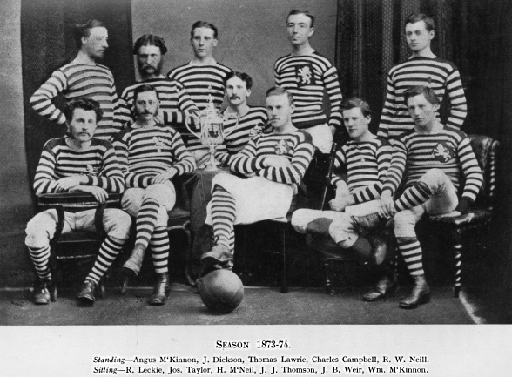
Language links
Ba is an example of a word which has cognates in many other European languages. It is often combined with words such as ‘hand’ or ‘foot’ to create names for objects or the game in which the object is used e.g. ‘handball’ and ‘football’. Note that the handball of Scotland bears no relation to the modern indoor sport played in Central Europe. The Scottish game is an ancestor of Squash.
The ba can apply to both the equipment and the game itself. In many parts of Scotland there are examples of ancient ba games which bear little relation to the Association Football code which was invented in Scotland.
A word sometimes related to ba – especially in live commentaries, and which you came across in the first example sentence of this activity is:
Definition: A jocular or colloq. name for a turnip (m. and s.Sc. 1973).
Go to the Dictionary of the Scots Language for a full definition of the word.
Language links
Tumshie is a good example of an ordinary term in Scots being used metaphorically in a pejorative fashion: as a piece of invective. The term appears to derive from the English ‘turnip’ and now has the definition of a contemptuous word for an idiot or someone of little use or skill. Football also provides us with related Scots phrases such as ‘ya lump a wid’ (you lump of wood), ‘he couldnae tackle a bag of cement’ (he could not even tackle an inanimate object) or ‘he’s a big stookie’ (he is as mobile as a scarecrow’).
Activity 10
Now find out about some historical aspects of the game of Fitba in Scotland. Former Open University student John Simkin wrote this summary of the early days of more formally organised Scottish men’s football.
While reading, take a note of things that are new to you, and of things that have not changed much since the early days of football in Scotland.
“The first international [men’s] football game [was] played on the 30th November, 1872 [at the West of Scotland Cricket Club with 4000 spectators]. [A] team of English born players [were to] play against a team from Scotland. The match, played in Glasgow, ended in a 0-0 draw. The main objective was to publicize the game of football in Scotland. It had the desired effect and the following year the Scottish Football Association was formed and the England-Scotland match became an annual fixture.
Initially, the Scottish Football Association comprised of eight clubs, 3rd Lanarkshire Rifle Volunteers, Clydesdale, Dumbreck, Eastern, Granville, Kilmarnock, Queen's Park and Vale of Leven. The SFA established a challenge cup and this was won by Queen's Park in its first year. Queen's Park also entered the FA Cup in its first season and reached the final in 1884 and 1885. Both times they lost to Blackburn Rovers. […]
The Scottish League was established in 1890. Since 1890 Glasgow Rangers and Celtic have dominated the competition. […]
Major William Sudell, the manager of a local factory in Preston, became the secretary of Preston North End. Sudell decided to improve the quality of the team by importing top players from other areas. This included several players from Scotland. […] In an attempt to stop this migration of players, the Scottish Football Association made it clear that it would not select players for the Scotland international side who played in England. This action failed to stop footballers moving south. […]
Between the First and Second World Wars, Scotland emerged as the leading football power in Britain. Their chief rivals were Wales who won the championship six times between 1920 and 1937.”
Answer
This is a model answer. The aspects you have listed might be different.
I did not know that the first men’s international football match ever played was played in Glasgow between Scotland and England and that as a result of this match the Scottish Football Association was formed. I also found it interesting to read how annual competitions in football might go back to this match, as it became an annual fixture at the end of the 19th century. It was also new to me that there were eight clubs in the first Scottish football league and that one of them is still in the Scottish Premier League: Kilmarnock. I was surprised to read that the FA Cup has such a long history and that in the early days of club football clubs from Scotland and England played in this competition together.
Interestingly, there are a number of things in Simkin’s text that have not changed much to this day:
- good Scottish players often still go south to play in England
- Celtic and Rangers are still dominating the Scottish league
- the FA Cup still exists
- and clubs like Kilmarnock and Queens Park Rangers still exist
8.5 The hidden story of Scottish football
Although the more institutionalised football game as we know it today emerged in the second half of the 19th century, football was already played in Scotland in the early Middle Ages. One of the reasons for this long tradition might be that football is a game that is easy to play – all that is needed are players, a bit of flat ground and a ball of some sort. Simkin states:
“Early games of football in Britain were played with blown-up animal bladders. These tended to burst and eventually most ball games played during the Middle Ages used a more solid ball. According to one historian of this period the ball was ‘usually a leather covering filled with cork shavings or a similar material.’”
And there is a widely neglected aspect of the long history of the game in Scotland, namely women’s football. Women throughout history actually had to fight to be able to play the game publically. BBC Scotland News maintains that “[w]omen's football is flourishing [today], but for centuries the game endured chronic discrimination, sexism and was even banned.” (BBC News, 2013)
Yet, Simkin highlights that Scotland was the place where women appear to have been introduced to the game first:
“[… it] seems to be the first country in the world to encourage women to play football. In the 18th century football was even linked to local marriage customs in the Highlands. Single women would play football games against married women. Single men would watch these games and use the evidence of their footballing ability to help them select prospective brides.”
The BBC Scotland News reports that:
“[c]hurch documents record women playing football in 1628 in Carstairs, Lanarkshire; A kirk session minute of January 1656 details drunkenness and fighting during both men's and women's games played on Fasting's eve; An annual match is said to have been contested by teams of married and single women near Inverness in the 1700s.”
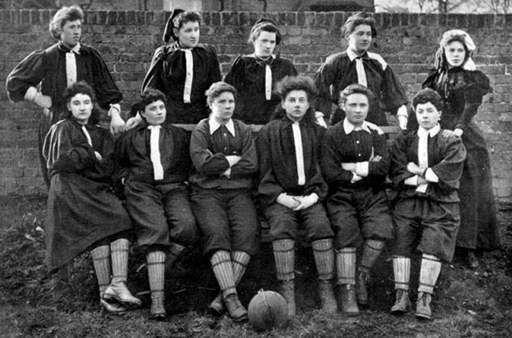
In the 19th century, Scottish women even played international football before their male counterparts did – a fact that tends not to be mentioned in reports about the history of football in Scotland. Here is an extract from the BBC Scotland News article ‘The Honeyballers: Women who fought to play football’ outlining the history of the women’s game in Scotland.
“Britain's first recorded international women's football match was played in Edinburgh in May 1881. A team representing Scotland beat one from England 3-0, with Lily St Clair scoring the opener. In a report following the match, the Glasgow Herald described the Scottish team as looking smart in blue jerseys, white knickerbockers, red belts and high heeled boots. Another game followed a few days later, this time in Glasgow. It had to be abandoned when hundreds of men ran on to the pitch. The players escaped on a bus drawn by four grey horses amid chaotic scenes of vandalism and fighting between spectators and police.
[…] In 1894, medical professionals called for girls and women to be banned completely from playing. However, some determined characters refused to be denied a sport that they were passionate about. The British Ladies Football Club was formed in 1895 with Dumfries aristocrat Lady Florence Dixie as its patron. Team captain was Mary Hutson who played under the pseudonym, Nettie Honeyball. […]
Later, during World War I, there was a brief revival. With thousands of men sent away to fight in the trenches, women took up traditional male roles in work and play. Dr Fiona Skillen, of Glasgow Caledonian University, said: "The First World War is a real critical point for women, especially working class women. […] you find that there is a growth in different kinds of sports, different kinds of leisure activities, because these young women are getting involved with them."
New teams emerged including one from Beardmore's Forge in Parkhead, Glasgow, that played an unofficial match against an English side at Celtic Park on 2 March 1918. Crowds of more than 50,000 turned out to watch games, but the end of the war was soon followed by an official British ban on the women's game in 1921. […] But the women's game survived thanks to the determination of teams both north and south of the border. […] Eventually the ban was officially lifted in the 1970s.”
Activity 11 
After reading the text about the history of women’s football, take some notes about the facts you personally find most interesting and enlightening. You may also want to compare what you have read here with the history of the men’s game.
Answer
This is a model answer. Your answer might be different.
I found this text really interesting as it showed that the tradition of women in football in Scotland is as old as that of men, however, as in other parts of our culture, the women’s footballing history has remained in the shadows of the men’s. I found it fascinating to read that football has provided women with a platform for fighting for their emancipation in Scotland. I was amazed to read that women playing football was part of an 18th century marriage custom in the Scottish Highlands, that the very first international football match was played by women in Scotland, that women’s football during World War I attracted crowds of over 50,000 spectators, and that the ban of women’s football in Britain lasted until the 1970s!
Activity 12
Look at a list of Scottish Football League clubs and their nicknames, which reflect the close connection of the clubs to their local communities.
Can you match the club names with their nicknames? When sorting the nicknames, keep in mind Scotland’s geography and possible local connections. Also think about Scots words you have come across in this course so far. If you need help, as always, go to the DSL.
Drag the nicknames to the position that you think fit with the correct club’s names. Some answers might be easier to deduct than others. Once you have found the right combinations, check the additional information we have provided in the note.
Using the following two lists, match each numbered item with the correct letter.
The Wee Rovers
The Red Lichties
The Wee Gers
The Gowfers
The Jags
The Doonhamers
The Bairns
a.Partick Thistle
b.Queen of the South
c.Carnoustie Panmure
d.Albion Rovers
e.Arbroath
f.Berwick Rangers
g.Falkirk
- 1 = d
- 2 = e
- 3 = f
- 4 = c
- 5 = a
- 6 = b
- 7 = g
Answer
Sport is an expression of culture. Football clubs are mostly named after the area in which they were founded. They are closely related to that area’s heritage, geography or work practices.
Falkirk’s name is taken from the Burgh motto: ‘Better meddle wi' the de'il than the Bairns o' Fa'kirk’. Arbroath take their name from the red light that was used to guide fishing boats into the Burgh’s harbour. The nickname of Queen of the South of Dumfries comes from the words doon hame, down home. Even when they were away, Dumfries people knew, in a deep cultural sense, where they belonged.
Here are some further explanations for the links between the clubs’ names and the nicknames they have been given by their fans. These come from an article on the Scots Language Centre website. On the website you can also listen to a recording with the Scots pronunciation of the nicknames.
Albion Rovers – called The Wee Rovers (the little Rovers). The word wee is, of course, the Scots word for little.
Arbroath – called The Reid Lichties (the little red lights) which is thought to refer to the red light that was used to guide fishing boats into the harbour of Arbroath.
Berwick Rangers – called The Borderers or The Wee Gers (the little Rangers) to distinguish them from Glasgow Rangers.
Carnoustie Panmure – called The Gowfers (the golfers). Carnoustie is, of course, well known for its golf courses. In Scots we say gowf and not golf which is an English pronunciation.
Falkirk – called The Bairns (the children). This nickname is taken from the motto of the burgh of Falkirk which warns: “Better meddle wi the deil than the Bairns o Fawkirk" (better meddle with the devil than the children of Falkirk). In Scots the name of the town is The Fawkirk (the speckled church).
Partick Thistle – called The Jags (the prickles). This derives from the Scots word jag or jaggie which means ‘prick/pierce’ or ‘prickly’ which is a good description of a thistle. The Scots for thistle is thrissle.
Queen of the South – called The Doonhamers (the downhomers). This is the local name for natives of Dumfries and also refers to doon which is one of the Scots words for a goal place (the other more common word for a goal in Scots is a dale.)
And here are some more interesting nicknames and their connections to the clubs:
Ayr United – called ‘The Honest Men’ which is taken from the Robert Burns poem ‘Tam o Shanter’ – ‘Auld Ayr, wham ne’er a town surpasses/ For honest men and bonie lasses’.
Clyde – called The Bully Wee (the good little). This probably derives from the Victorian word ‘bully’, meaning good or first rate and because the club was quite small it was known as the The Bully Wee Clyde (the first rate little Clyde).
Glasgow Rangers – called The Gers or The Licht Blues (the Light Blues) from the original colour of the jersey. In the last few years the motto of the club Aye Ready (always ready) has, for some reason, simply become ‘Ready’, dropping the Scots aye altogether. In Scots the city is called Glesca or Glescae.
Saint Mirren – called The Buddies (the people) which is derived from the Scots body, meaning ‘person’ and often pronounced to sound like buddie.
Please note: It might be useful to look up in the DSL the entries for the Scots words contained in the nicknames you have come across in this activity. This will help you see how these words were derived. To make this easier for you, here the links to the DSL.
Arbroath: The Red Lichties
Clyde: The Bully Wee
Falkirk: The Bairns
Forfar Athletic: The Loons
Montrose: The Gable Endies
Peterhead: The Blue Toon
Queen of the South: The Doonhamers
St Mirren: The Buddies
8.6 What I have learned
The final activity of this section is designed to help you review, consolidate and reflect on what you have learned in this unit. You will revisit the key learning points of the unit and the initial thoughts you noted down before commencing your study of it.
Activity 13
Before finishing your work on this unit, please revisit what you worked on in Activity 1, where we asked you to take some notes on what you already knew in relation to the key learning points of the unit.
Compare your notes from before you studied this unit with what you have learned here and add to these notes as you see fit to produce a record of your learning.
Here are the key learning points again for you as a reminder:
A comparison of the games of curling and bool, and Scots words related to these games
The history of men’s and women’s football in Scotland
The influence of Scottish culture on important world sports as seen in Scots sports vocabulary language links
The history of the ‘tools’ used for playing golf
Further research
Sport has been a subject for literature only occasionally. However, some of Scotland's greatest writers have produced work in the Scots language.
Look for the folk song Fitba Crazy which was originally written by James Curran in the 19th century and has changed throughout the following decades. It became a British pop hit in 1960 for Robin Hall and Jimmy McGregor. Compare the written words on Sangstories to the lyrics on YouTube which have been slightly altered for a non-Scots audience.
Robert Burns included a poem on Curling in his elegy for his friend Tam Samson who had not yet died when it was written! Poem: ‘Tam Samson's Elegy’.
An explanation of some of the terms used in Curling can be found in the RCCC's History of the Game.
Find out more about the similarities of Curling and Bowls in Encyclopaedia Britannica (2018) Curling and A Tomlinson's A Dictionary of Sports Studies, Oxford University Press.
An interesting insight into women’s football in Britain is provided in: Tate, T. (2013) Girls with Balls: The Secret History of Women’s Football, London, John Blake Publishing.
To listen to the Scots language in a sports context, tune in to the Off the Ball football show, which you have already come across in unit 1, on BBC Radio Scotland, moderated by Tam Cowan and Stuart Cosgrove. This website, with a wide collection of clips and live programmes, highlights that Scots is very much a living language of Scotland.
Another interesting recording is a short interview with Stuart Cosgrove from the Off the Ball radio show, in which he talks about how his childhood shaped the language he uses. Cosgrove “discusses how important Scots words are in relation to any discussion about Scottish football. He reflects on his childhood and how the language of the playground was Scots and the language of the classroom was more formal English. He invites the viewers to take pride in their language and continue to celebrate their culture and history by using it”.
If you want to listen to a recording about football in the Doric dialect, listen to ‘Auchterturra’, a comic performance by one the characters from 'Scotland the What?'. An Aberdeen football fan addresses a humorous good luck message to his team, on behalf of the fictitious village of Auchterturra, and expresses his unhappiness at being unable to be at the match himself.
Listen to Rhona Martin speak about Scots language and curling in this BBC Bitesize clip. The Olympic Curling champion explains how stones on the rink can often create a messy picture and resemble a 'guddle'. Rhona talks us through the games leading up to the Gold medal performance and the dramas on the way to victory. She comments on being 'scunnered' and 'crabbit' on occasion, suggesting that the sport has its ups and downs.
Now go on to Unit 9: Drama, television and film.
References
Acknowledgements
Every effort has been made to contact copyright holders. If any have been inadvertently overlooked the publishers will be pleased to make the necessary arrangements at the first opportunity.
Grateful acknowledgement is made to the following sources:
Course Image: Supplied by Bruce Eunson / Education Scotland
Image in Activity 2: razvan.orendovici. This file is licensed under the Creative Commons Attribution-NonCommercial-ShareAlike Licence http://creativecommons.org/licenses/by-nc-sa/2.0
Image in Activity 3: Jonathan Pope, cropped by Beyond My Ken / https://commons.wikimedia.org/wiki/File:Olympic_Curling,_Vancouver_2010_crop_sweeping.jpg. This file is licensed under the Creative Commons Attribution Licence http://creativecommons.org/licenses/by/2.0/
Bret Arnett. This file is licensed under the Creative Commons Attribution-NonCommercial-ShareAlike Licence http://creativecommons.org/licenses/by-nc-sa/2.0/
John Boyd/ Archives of Ontario
Image on page 12: Sir James Macdonald 1741 - 1766 and Sir Alexander Macdonald 1744/1745 - 1795. Access no: PG 2127, National Galleries Scotland, purchased 1967. Photograph: Antonia Reeve
Image on page 15: Tour Scotland Photographs. This file is licensed under the Creative Commons Attribution-NonCommercial- NoDerivs Licence http://creativecommons.org/licenses/by-nc-nd/2.0/
Image on page 16: X3A Collection/ Alamy
Image on page 17: byb64. This file is licensed under the Creative Commons Attribution-NonCommercial-ShareAlike Licence http://creativecommons.org/licenses/by-nc-sa/2.0
Image on page 18: Dr Sylvia Warnecke
Image on page 19: Mattinbgn. This file is licensed under the Creative Commons Attribution-NonCommercial-ShareAlike Licence http://creativecommons.org/licenses/by-sa/4.0/
Image on page 20: Joel Abroad. This file is licensed under the Creative Commons Attribution-NonCommercial-ShareAlike Licence http://creativecommons.org/licenses/by-nc-sa/2.0
Image on page 21: k4dordy. This file is licensed under the Creative Commons Attribution 2.0 Licence http://creativecommons.org/licenses/by/2.0
Image in Activity 9: Roger May. This file is licensed under the Creative Commons Attribution-Noncommercial-NoDerivatives Licence http://creativecommons.org/licenses/by-nc-nd/2.0/
Text
Extract in Activity 10: Simkin, J. (1997) Football in Scotland. Updated 2014. spartacus-educational.com. © 1997-2016 Spartacus Educational Publishers Ltd.
Extract on pages 26 and 30: BBC News Scotland (2013) ‘The Honeyballers: Women who fought to play football’, https://www.bbc.co.uk/news/uk-scotland-highlands-islands-24176354. BBC News
